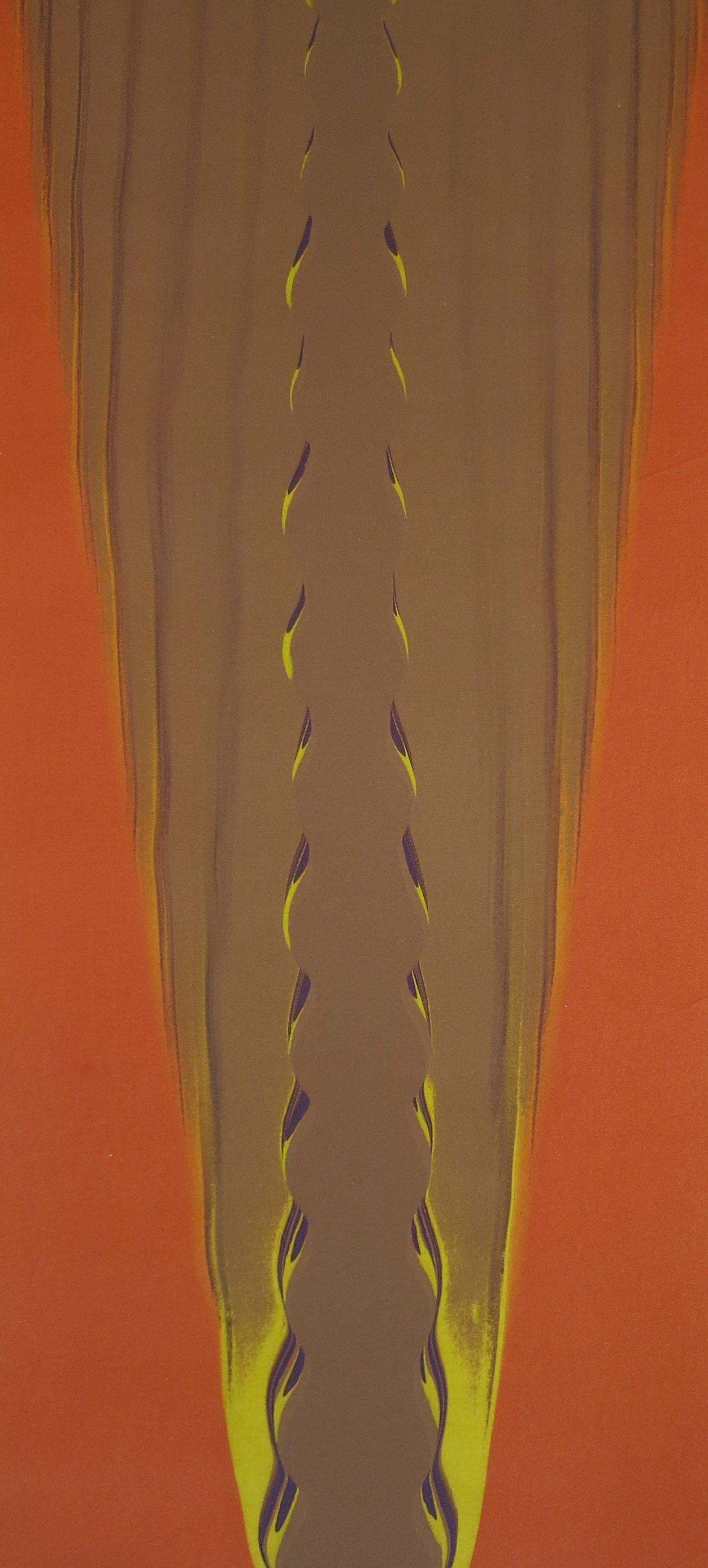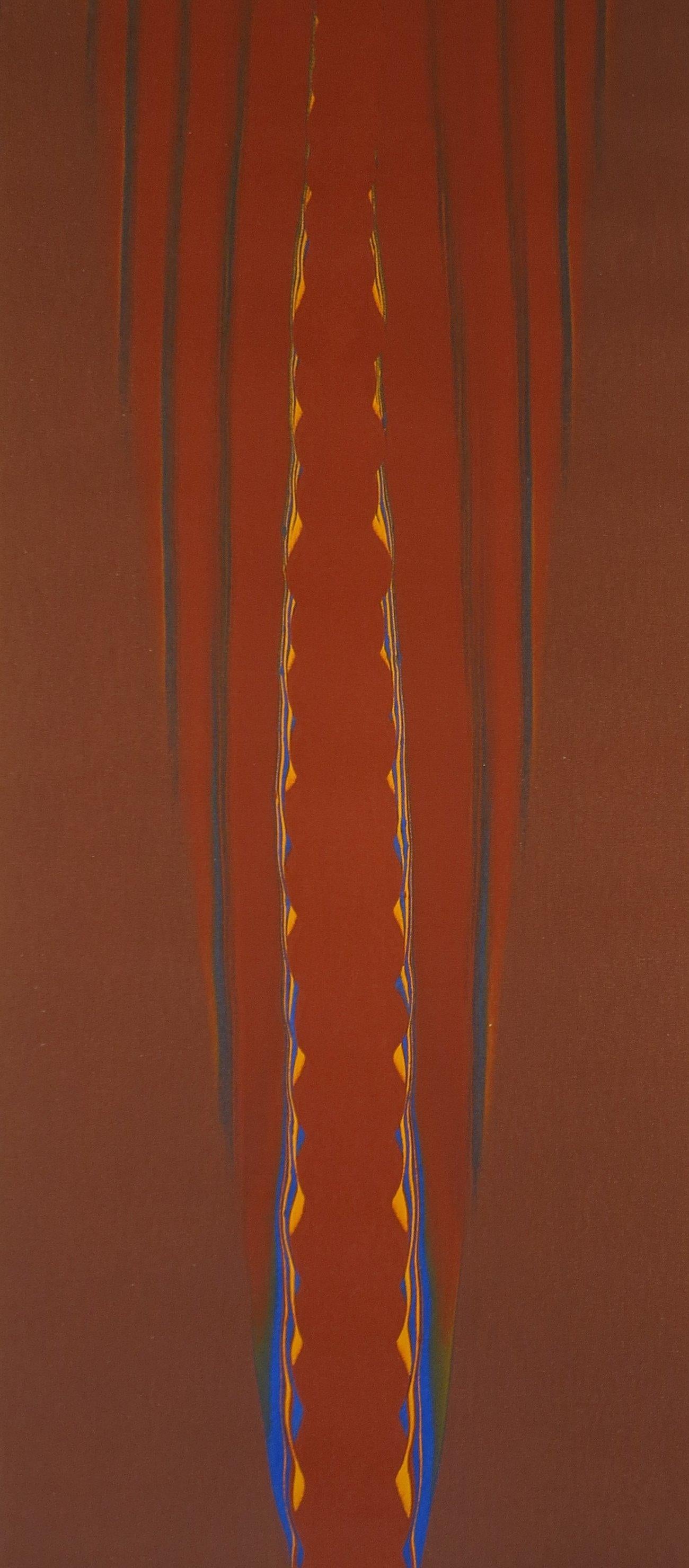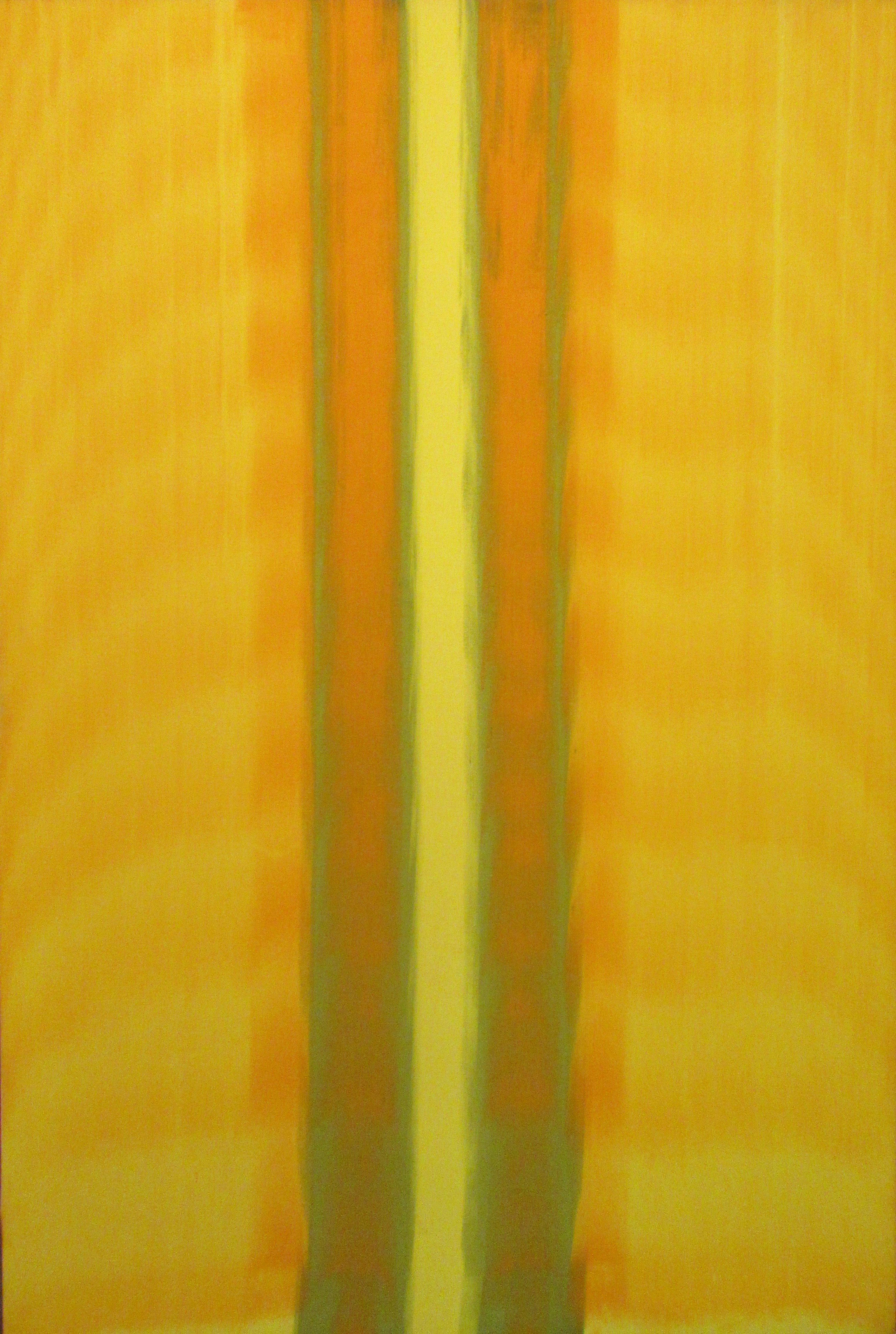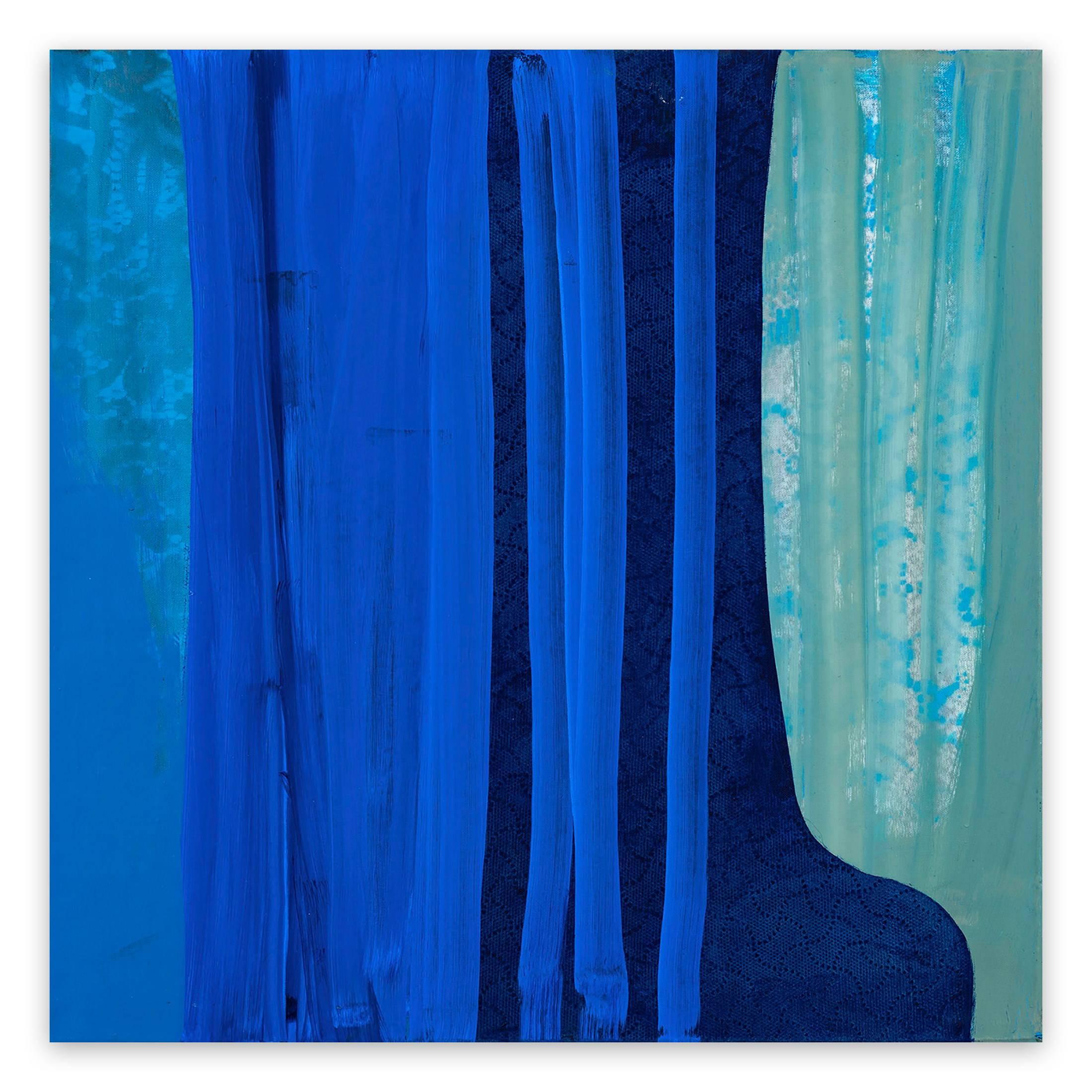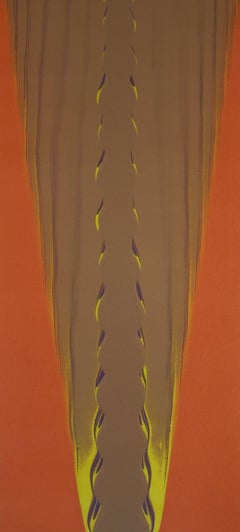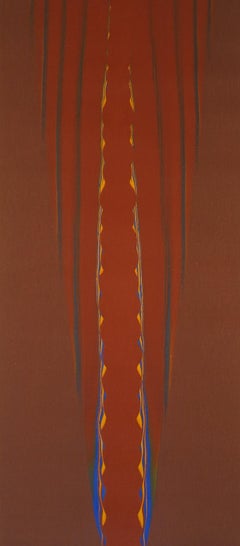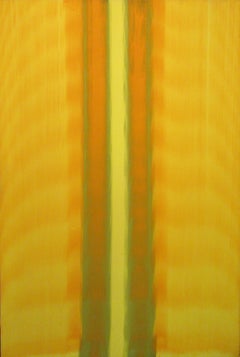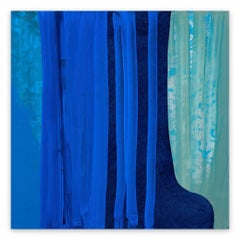Items Similar to "Inside Blue" Gene Hedge, Abstract Color Field, Bauhaus Midcentury Painting
Want more images or videos?
Request additional images or videos from the seller
1 of 2
Gene Hedge"Inside Blue" Gene Hedge, Abstract Color Field, Bauhaus Midcentury Painting1966
1966
$20,000
£15,158.85
€17,547.86
CA$28,234.80
A$31,441.70
CHF 16,416.43
MX$380,974.51
NOK 207,028.54
SEK 195,347.75
DKK 130,992.68
About the Item
Gene Hedge
Inside Blue, 1966
Acrylic on canvas
61 1/4 x 43 3/4 inches
(P124)
Gene Hedge was born (1928) and raised in rural Indiana. After military service, he briefly attended Ball State University in Muncie, Indiana. There he encountered the writing of Laszlo Moholy-Nagy, and the following year (1949) went to study at the Institute of Design in Chicago. He received a B.S. degree in Visual Design from the Institute of Design (1953), and he also took courses at the Art Institute of Chicago and began working in collage.
During this period, the influence of Eugene Dana (painter 1912-1996), Aaron Siskind (photographer 1903-1991), and Robert Nickle (designer & collagist 1919-1980) became especially important, first as teachers at the Institute of Design and later as friends. At the School of the Art Institute of Chicago, Hedge became involved with the Exhibition Momentum group of young artists, exhibiting his collages in the 1954 show.
Picked-up by Allan Frumkin Gallery in Chicago, Hedge soon began to show his distinctive collage-paintings in group shows around the United States including the Carnegie International exhibition in Pittsburgh (1955) and the Art Institute of Chicago (1956). It was in this year that Hedge relocated to New York City.
His work was then included in the New Talent/Art in America at New York City’s Rockefeller Center (1959), Contemporary American Painting at the Whitney Museum of American Art (1963), Collage in America at the Museum of Modern Art (1966), 100 Years: 100 Artists at Art Institute of Chicago (1979). Hedge was represented by B.C. Holland Gallery (Chicago) and the Poindexter Gallery (New York), and he also showed at the Stable Gallery (New York) and other galleries and museums across the United States.
In the early 1970s, Hedge began traveling to explore new landscapes, art and architecture, especially that of the Southwestern United States, the Middle-East, and India. During these often-lengthy journeys, he photographically documented all that he was experiencing visually. Having formally studied multiple artistic disciplines, Hedge expanded his work exploring new painting techniques and lithography.
From an early age, Hedge observed an asymmetrical order to natural objects like fruit, fish, feathers, or seashells. Using macro-digital photography and large format printmaking, Hedge’s work provides a viewer with a sense of joy and wonder through un-manipulated images of natural visual organizations normally unseen by the human eye.
Gene Hedge taught students and teachers and developed educational programs in design at the School of Design, North Carolina State University, Raleigh, N.C. (1968 -1973), and the University of Illinois at Chicago (1980-1986).
Hedge’s works are represented in the permanent collections of:
Art Institute of Chicago (Chicago, IL)
Bauhaus Chicago Archive (Chicago, IL)
The Chase Manhattan Bank (New York, NY)
Chicago Historical Society, Institute of Design Collection, (Chicago, IL)
James Michener Collection at Blanton Art Museum (Austin, Texas)
The Lannan Foundation (Santa Fe, NM)
Poindexter Collection at Yellowstone Art Museum (Billings, MT)
Museum of Contemporary Art (Chicago, IL)
Union Carbide (New York)
University of Illinois, Institute of Design Archive, (Chicago, IL)
Whitney Museum of American Art (New York)
And private collections
About the Seller
5.0
Platinum Seller
Premium sellers with a 4.7+ rating and 24-hour response times
Established in 2022
1stDibs seller since 2022
119 sales on 1stDibs
Typical response time: <1 hour
- ShippingRetrieving quote...Shipping from: New York, NY
- Return Policy
Authenticity Guarantee
In the unlikely event there’s an issue with an item’s authenticity, contact us within 1 year for a full refund. DetailsMoney-Back Guarantee
If your item is not as described, is damaged in transit, or does not arrive, contact us within 7 days for a full refund. Details24-Hour Cancellation
You have a 24-hour grace period in which to reconsider your purchase, with no questions asked.Vetted Professional Sellers
Our world-class sellers must adhere to strict standards for service and quality, maintaining the integrity of our listings.Price-Match Guarantee
If you find that a seller listed the same item for a lower price elsewhere, we’ll match it.Trusted Global Delivery
Our best-in-class carrier network provides specialized shipping options worldwide, including custom delivery.More From This Seller
View All"Untitled" Gene Hedge, Abstract Color Field, Red Blue Green Midcentury Painting
Located in New York, NY
Gene Hedge
Untitled, circa 1970
Acrylic on canvas
48 x 18 inches
Provenance
Estate of the artist
Gene Hedge was born (1928) and raised in rural Indiana. After military service, he...
Category
1970s Abstract Abstract Paintings
Materials
Canvas, Acrylic
"Untitled" Gene Hedge, Abstract Color Field, Red Blue Orange Midcentury Painting
Located in New York, NY
Gene Hedge
Untitled, circa 1970
Acrylic on canvas
48 x 18 inches
Provenance
Estate of the artist
Gene Hedge was born (1928) and raised in rural Indiana. After military service, he...
Category
1970s Color-Field Abstract Paintings
Materials
Canvas, Acrylic
"Untitled" Gene Hedge, Abstract Color Field, Yellow Midcentury Painting
Located in New York, NY
Gene Hedge
Untitled, circa 1966
Acrylic on canvas
61 1/2 x 42 1/8 inches
(P122)
Gene Hedge was born (1928) and raised in rural Indiana. After military service, he briefly attended Ball State University in Muncie, Indiana. There he encountered the writing of Laszlo Moholy-Nagy, and the following year (1949) went to study at the Institute of Design in Chicago. He received a B.S. degree in Visual Design from the Institute of Design (1953), and he also took courses at the Art Institute of Chicago and began working in collage.
During this period, the influence of Eugene Dana...
Category
1960s Abstract Abstract Paintings
Materials
Canvas, Acrylic
"Emblem" Gene Hedge, Abstract Color Field, Black Midcentury Bauhaus Painting
Located in New York, NY
Gene Hedge
Emblem, 1976
Acrylic on canvas
19 1/2 x 58 1/2 inches
(P063)
Gene Hedge was born (1928) and raised in rural Indiana. After military service, he briefly attended Ball Stat...
Category
1970s Abstract Abstract Paintings
Materials
Canvas, Acrylic
"Untitled" Gene Hedge, Abstract Color Field, Yellow Pattern Midcentury Painting
Located in New York, NY
Gene Hedge
Untitled, circa 1970
Acrylic on canvas
29 x 20 3/4 inches
(P097)
Gene Hedge was born (1928) and raised in rural Indiana. After military service, he briefly attended Ball State University in Muncie, Indiana. There he encountered the writing of Laszlo Moholy-Nagy, and the following year (1949) went to study at the Institute of Design in Chicago. He received a B.S. degree in Visual Design from the Institute of Design (1953), and he also took courses at the Art Institute of Chicago and began working in collage.
During this period, the influence of Eugene Dana...
Category
1970s Abstract Abstract Paintings
Materials
Canvas, Acrylic
"Untitled" Gene Hedge, Abstract Color Field, Purple Orange Blue Midcentury Work
Located in New York, NY
Gene Hedge
Untitled, circa 1970
Acrylic on canvas
48 x 18 inches
Provenance
Estate of the artist
Gene Hedge was born (1928) and raised in rural Indiana. After military service, he...
Category
1970s Abstract Abstract Paintings
Materials
Acrylic
You May Also Like
Blue Abstract Painting
By Walter Swyrydenko
Located in Lake Worth Beach, FL
Blue Navy Abstract,
Size: 31x36.5 framed 32x37.7
Walter Swyrydenko was born in Sloviansk, Ukraine in 1942. A graduate of Kent State University, receiving a B.S. in Art Education and an M.A. in Painting. Studied in Paris, France. Professor of Art at Lakeland Community College. He was awarded the rank of Professor Emeritus in 2002 by Lakeland Community College, and held a retrospective of his work, "A Look Back 1965-2001," at the LCC Gallery in 2003. Listed in Marquis’ “Who’s Who Dictionary of International Biography,” “ Leaders of America,” “Who’s Who in the Arts, 1971-1972,” Artists/USA, 1972-1973, 1974-1975,” “Outstanding Young Men of America,”1971,” International Who’s Who in Art and Antiques, 1972,”
Annuaire De L’Art International, 1974-1975, 1975-1976,” “Library Of Human Resources...
Category
1960s Abstract Geometric Abstract Paintings
Materials
Cotton Canvas, Oil
Blue Shift (Abstract painting)
By Marcy Rosenblat
Located in London, GB
Acrylic on linen. Unframed.
The textured appearance of her paintings emanates from the intervention of common household products such as paper towels during the painting process.
M...
Category
2010s Abstract Abstract Paintings
Materials
Linen, Acrylic
Blue Shift (Abstract painting)
By Marcy Rosenblat
Located in London, GB
Blue Shift (Abstract painting)
Acrylic on linen. Unframed.
The textured appearance of her paintings emanates from the intervention of common household products such as paper towels...
Category
2010s Abstract Abstract Paintings
Materials
Linen, Acrylic
Blue Shift (Abstract painting)
By Marcy Rosenblat
Located in London, GB
Blue Shift (Abstract painting)
Acrylic on linen. Unframed.
The textured appearance of her paintings emanates from the intervention of common household products such as paper towels...
Category
2010s Abstract Abstract Paintings
Materials
Linen, Acrylic
Sea, Royal Blue Abstraction
By John Zinsser
Located in Greenwich, CT
Rich blue lush color is the feature of this motivating abstraction by well known minimalist John Zinsser. From his series of works celebrating a correlation with Theodore's Stamos, ...
Category
2010s Abstract Abstract Paintings
Materials
Enamel
Blue Fusion 2, Painting, Acrylic on Canvas
By Nestor Toro
Located in Yardley, PA
Acrylic abstract blue, red, some green expressive contrasting color field painting. Textured and layered with fluid translucent acrylics and iridescent mediums. ORIGINAL FINE ABST...
Category
2010s Abstract Abstract Paintings
Materials
Acrylic
More Ways To Browse
Southwestern Paintings
Southwestern Abstract
Abstract Southwestern Art
Yellowstone Paintings
Seashell Art
Large Southwestern Painting
Seashell Painting
James Michener
Robert Indiana 1968
Vintage Raleigh
Robert Indiana 1996
Dana James
Eugene Dana
Santa Barbara Oil Painting
Charms Mexico
Paintings Rodal
Abstract Party Painting
Long Horizontal Paintings
